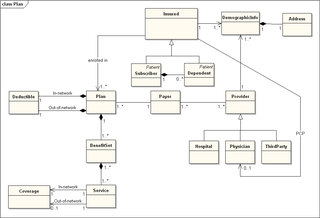In information science, an ontology encompasses a representation, formal naming, and definitions of the categories, properties, and relations between the concepts, data, or entities that pertain to one, many, or all domains of discourse. More simply, an ontology is a way of showing the properties of a subject area and how they are related, by defining a set of terms and relational expressions that represent the entities in that subject area. The field which studies ontologies so conceived is sometimes referred to as applied ontology.
Model Driven Architecture (MDA) is a software design approach for the development of software systems. It provides a set of guidelines for the structuring of specifications, which are expressed as models. Model Driven Architecture is a kind of domain engineering, and supports model-driven engineering of software systems. It was launched by the Object Management Group (OMG) in 2001.

An entity–relationship model describes interrelated things of interest in a specific domain of knowledge. A basic ER model is composed of entity types and specifies relationships that can exist between entities.

Object–role modeling (ORM) is used to model the semantics of a universe of discourse. ORM is often used for data modeling and software engineering.

An information model in software engineering is a representation of concepts and the relationships, constraints, rules, and operations to specify data semantics for a chosen domain of discourse. Typically it specifies relations between kinds of things, but may also include relations with individual things. It can provide sharable, stable, and organized structure of information requirements or knowledge for the domain context.

In software engineering, a domain model is a conceptual model of the domain that incorporates both behavior and data. In ontology engineering, a domain model is a formal representation of a knowledge domain with concepts, roles, datatypes, individuals, and rules, typically grounded in a description logic.
In information science, an upper ontology is an ontology that consists of very general terms that are common across all domains. An important function of an upper ontology is to support broad semantic interoperability among a large number of domain-specific ontologies by providing a common starting point for the formulation of definitions. Terms in the domain ontology are ranked under the terms in the upper ontology, e.g., the upper ontology classes are superclasses or supersets of all the classes in the domain ontologies.
In computer science and artificial intelligence, ontology languages are formal languages used to construct ontologies. They allow the encoding of knowledge about specific domains and often include reasoning rules that support the processing of that knowledge. Ontology languages are usually declarative languages, are almost always generalizations of frame languages, and are commonly based on either first-order logic or on description logic.
The general formal ontology (GFO) is an upper ontology integrating processes and objects. GFO has been developed by Heinrich Herre, Barbara Heller and collaborators in Leipzig. Although GFO provides one taxonomic tree, different axiom systems may be chosen for its modules. In this sense, GFO provides a framework for building custom, domain-specific ontologies. GFO exhibits a three-layered meta-ontological architecture consisting of an abstract top level, an abstract core level, and a basic level. Primarily, the ontology GFO:
Executable UML is both a software development method and a highly abstract software language. It was described for the first time in 2002 in the book "Executable UML: A Foundation for Model-Driven Architecture". The language "combines a subset of the UML graphical notation with executable semantics and timing rules." The Executable UML method is the successor to the Shlaer–Mellor method.
Visual modeling is the graphic representation of objects and systems of interest using graphical languages. Visual modeling is a way for experts and novices to have a common understanding of otherwise complicated ideas. By using visual models complex ideas are not held to human limitations, allowing for greater complexity without a loss of comprehension. Visual modeling can also be used to bring a group to a consensus. Models help effectively communicate ideas among designers, allowing for quicker discussion and an eventual consensus. Visual modeling languages may be General-Purpose Modeling (GPM) languages or Domain-Specific Modeling (DSM) languages. Visual modelling in computer science had no standard before the 90's, and was incomparable until the introduction of the UML. They include industry open standards, as well as proprietary standards, such as the visual languages associated with VisSim, MATLAB and Simulink, OPNET, NetSim, NI Multisim, and Reactive Blocks. Both VisSim and Reactive Blocks provide a royalty-free, downloadable viewer that lets anyone open and interactively simulate their models. The community edition of Reactive Blocks also allows full editing of the models as well as compilation, as long as the work is published under the Eclipse Public License. Visual modeling languages are an area of active research that continues to evolve, as evidenced by increasing interest in DSM languages, visual requirements, and visual OWL.
The Foundational Model of Anatomy Ontology (FMA) is a reference ontology for the domain of human anatomy. It is a symbolic representation of the canonical, phenotypic structure of an organism; a spatial-structural ontology of anatomical entities and relations which form the physical organization of an organism at all salient levels of granularity.
DOGMA, short for Developing Ontology-Grounded Methods and Applications, is the name of research project in progress at Vrije Universiteit Brussel's STARLab, Semantics Technology and Applications Research Laboratory. It is an internally funded project, concerned with the more general aspects of extracting, storing, representing and browsing information.
There is a large body of knowledge that designers call upon and use during the design process to match the ever-increasing complexity of design problems. Design knowledge can be classified into two categories: product knowledge and design process knowledge.
The triune continuum paradigm is a paradigm for general system modeling published in 2002. The paradigm allows for building of rigorous conceptual frameworks employed for systems modeling in various application contexts.
Ontology Grounded Metalanguage (OGML) is a metalanguage like MOF. The goal of OGML is to tackle the difficulties of MOF: linear modeling architecture, ambiguous constructs and incomprehensible/unclear architecture.

In information science a conceptualization is an abstract simplified view of some selected part of the world, containing the objects, concepts, and other entities that are presumed of interest for some particular purpose and the relationships between them. An explicit specification of a conceptualization is an ontology, and it may occur that a conceptualization can be realized by several distinct ontologies. An ontological commitment in describing ontological comparisons is taken to refer to that subset of elements of an ontology shared with all the others. "An ontology is language-dependent", its objects and interrelations described within the language it uses, while a conceptualization is always the same, more general, its concepts existing "independently of the language used to describe it". The relation between these terms is shown in the figure to the right.

Menthor Editor is a no longer maintained free ontology engineering tool for dealing with OntoUML models. It included OntoUML syntax validation, Alloy simulation, Anti-Pattern verification, and MDA transformations from OntoUML to OWL, SBVR and Natural Language.
Giancarlo Guizzardi is a Brazilian–Italian computer scientist specializing in conceptual modeling, enterprise modeling, applied ontology and ontology-driven information systems. He is a professor in the University of Twente in The Netherlands and a senior researcher and founding member of the Ontology & Conceptual Modeling Research Group (NEMO) in Vitoria, Brazil.
The Unified Foundational Ontology (UFO). is an ontological framework developed in the early 2000s with the objective of providing foundational support for conceptual modeling. It synthesizes elements from formal ontology, cognitive science, linguistics, and philosophical logic to inform the structure and semantics of conceptual models. The ontology is utilized to articulate a variety of fundamental notions within conceptual modeling, offering a systematic approach to categorizing entities and delineating their properties.





